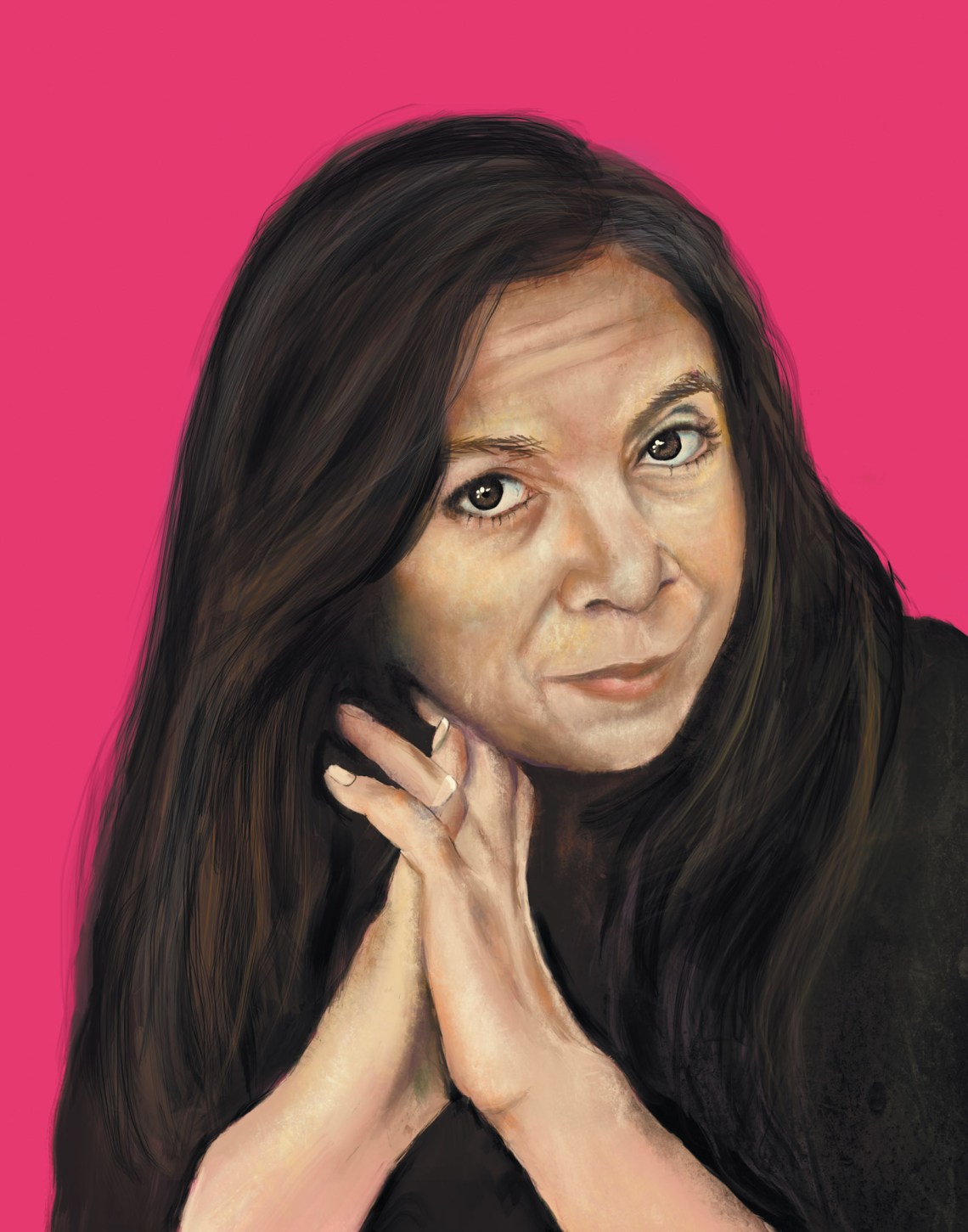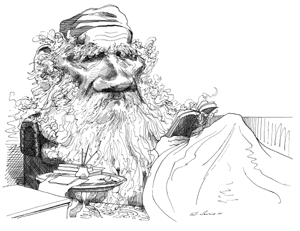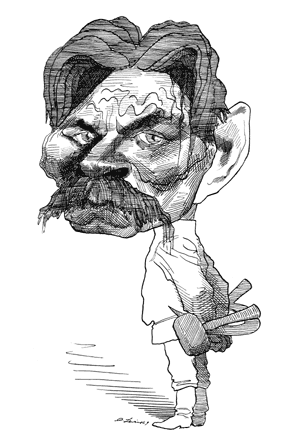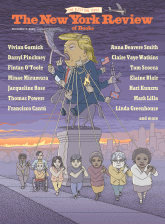In 1899 Anton Chekhov wrote to Maxim Gorky, an up-and-coming writer whose stories had caught his and Tolstoy’s attention:
The day before yesterday I was at L.N. Tolstoy’s; he praised you very highly and said that you were “a remarkable writer.” He likes your “The Fair” and “In the Steppe,” and does not like “Malva.” He said: “You can invent anything you like, but you can’t invent psychology, and in Gorky one comes across just psychological inventions: he describes what he has never felt.”
In another letter, Chekhov advised Gorky against his tendency to write like “a spectator in the theater who expresses his delight with so little restraint that he prevents himself and others from listening.” One wonders if Gorky ever heeded this advice. In his fiction, characters are often given stage directions: “cried with jealousy in his voice,” “exclaimed admiringly,” or “laughed an indulgent laugh.” The three-volume Autobiography of Maxim Gorky, wonderfully populated with all kinds of characters, would have been more engaging if not for Gorky’s habitual emphasis on “this extraordinary Russian life,” “the misery and murky lives” of Russian people, or his own awakening: “My swelling heart almost split under pressure of many strange emotions, and I felt an encompassing, inarticulate love for all human beings and all the earth.”
I thought of Gorky while reading Carmen Boullosa’s new novel, The Book of Anna, even before Gorky himself is briefly mentioned in it. “Anna” in the title refers to Anna Karenina, so I thought of Tolstoy also, and he too makes an appearance, more demandingly, as he “barges” into two characters’ dreams. It is a high-wire act for a novel to present not only Gorky and Tolstoy, but also their characters—one group taken directly from Anna Karenina, and another that seems to have stepped out of Gorky’s work. The audacity of taking such a risk is perhaps all that matters. And falling short is a feat too, when it is falling short of the impossible.
Boullosa is one of the leading Mexican voices in contemporary literature.* Her novels share a mischievous joy in storytelling, world-building, and blending history and fiction into dreamlike landscapes. Her vivacity and humor are infectious: a reader often feels jostled. Her Texas: The Great Theft, a novel set on the Texas–Mexico border in 1859 and featuring a large cast of characters living in a historical moment rife with political and racial conflicts, is exhilarating both in scope and imagination.
The Book of Anna starts with some hypothetical questions: What happens to Anna Karenina’s children—Sergei, her son with Karenin, and Anya, her daughter with Vronsky—after her death? And what happens to the children’s book that Anna was working on, which we are given only a glimpse of in Anna Karenina? “She’s writing a book for children and doesn’t tell anybody about it, but she read it to me,” Stiva, Anna’s brother, tells Levin. It is the only time that Anna’s work-in-progress is mentioned.
Years ago, a radio host said to me wistfully before we went on the air, “If only Tolstoy didn’t let Anna die. We should have a book with Anna living on and marrying her lover.” To wish for an alternative fate for a character—or a continuation of the story—is proof of a reader’s attachment. Only a handful of novels, though, sustain these reimaginations. Most, after all, are like people we meet: we take them for who they are, and we don’t feel the urge to rewrite their pasts, or make changes to their futures.
To take characters out of their original habitats and create a variation on their stories is not a new idea. Plenty of Jane Austen’s characters meander in the landscape of contemporary literature; see, for instance, Pride and Prejudice and Zombies. “The madwoman in the attic,” freed from Charlotte Brontë’s Jane Eyre, unfolds her own story in Jean Rhys’s Wide Sargasso Sea. In The Book of Anna, Boullosa ingeniously gives Sergei and Anya a different kind of existence: they retain their fictional origin and are known to the other characters in the novel as the Karenin siblings given birth to by Tolstoy’s pen. Like celebrity children growing up in the public eye, they have gained notoriety not because of who they are, but who their parents are.
Boullosa’s novel is set in St. Petersburg in 1905, twenty-seven years after the publication of Anna Karenina. Sergei, the boy abandoned by his mother, has grown into a middle-aged, married man, full of uncertainty and shame, sensing too well that his being cannot be separated from the novel that exposed his mother. Dwelling upon his fate leads him to imagine torments from others. “You’re Karenina’s son; she fell in love with Vronsky and abandoned you. And what did she see in Vronsky?”—such is the refrain that plagues Sergei’s mind.
Advertisement
His tormentors, enthralled by his creator, are actually more concerned with his social status. During intermission at a concert he is accosted by an ambassador:
He takes a step into the box, cornering Sergei. “I’ve read Tolstoy’s novel so many times that you could even say I’ve memorized it. I’m overcome by the incredible opportunity to speak with one of its characters….”
A similar fate befalls Anya, though, as Boullosa writes, she “barely appears in the novel in which she was born, and that gives her personality more breadth.” Hardly known to her birth father, hardly loved by her birth mother, and raised by Karenin with “combinations of affection and hostility, tenderness and betrayal,” Anya, more than her brother, is a brilliant creation, entirely Boullosa’s. A fictional character like Sergei, Anya nevertheless has enough insouciance to treat their origin story, monumental to her brother, as merely accidental. Like the society ladies in Tolstoy’s novels, Anya strives to enjoy fully a material life lived on the surface.
What an inconvenient predicament then that her own servants cannot forget her mother—downstairs the maids speculate about the contraceptives Anna used to avoid childbearing after Anya’s birth. And what a disappointment when she fails to attract the right people with her fictional origin. At the concert, she is not recognized as Sergei is:
Anya has passed unnoticed by the eyes of this particular reader. Neither her beauty nor her likeness to the protagonist caught his attention. “Another one who forgot I was ever born,” she says under her breath.
But it is 1905, and the tsar’s court and aristocratic society are no longer the center of the historical narrative. Gaponists, anarchists, Bolsheviks, sailors onboard the battleship Potemkin, and myriad other characters together enter the novel and put on what Lenin called “the great dress rehearsal” for the Russian Revolution of 1917. Anya’s maid marches next to Father Gapon himself, the Orthodox priest and leader of the Assembly of Russian Factory and Mill Workers, on what came to be known as Bloody Sunday. The wife of Matyushenko, the leader of the Potemkin mutiny, works in Anya’s kitchen. The footman working for Sergei and his wife, Claudia, makes up a song to entertain himself that is accidentally picked up by the protesters as their battle hymn.
This intersection between fiction and history, however, does not make the historical figures in the novel into successful characters. For instance, Alexandra Kollontai, the Marxist feminist who later had a distinguished political and diplomatic career serving the Soviet regime, shows up in the novel on Bloody Sunday. “From now on things are going to be different,” she announces at the march. In real life Kollontai was a witness to Bloody Sunday, but that fact alone does not make her a convincing character. The novel could have easily arranged a persuasive connection for her: a childhood friend working as a maid at the Karenins’, a chance encounter with Anya or Sergei, or an encounter with Clementine, a seamstress-turned-anarchist whose two attempts at public bombings bookend the novel. But the connection that goes unmade raises a theoretical question: Is it the birthright of a historical figure to be included in a novel set in their period? To what end should a novel include a historical figure like Kollontai—merely as a garnish?
One doesn’t have to look far to discover historical figures as robust characters. Napoleon in War and Peace has a memorable performance, peeling a glove off his white hand; sighing over the wounded Bolkonsky on the battlefield, “Voilà, une belle mort”; and saying, in one of my favorite moments, when he is presented with a portrait of his young son right before the Battle of Borodino, “Take him away” while “pointing to the portrait with a gracefully majestic gesture. ‘It is still too early for him to look upon a field of battle.’” This is not only history’s Napoleon, but also Tolstoy’s Napoleon, a dramatist who writes for himself, the only actor who matters.
The historical figures in The Book of Anna—Kollontai, Father Gapon, the sailors on board the Potemkin—fulfill their roles in the historical narrative of 1905, but they, like wax figures in a museum, don’t inspire imagination or curiosity. One wishes that Boullosa’s inventive touch extended to them, so that Kollontai were not only history’s Kollontai, but also Boullosa’s.
Characters in fiction start with uncertainties and end with yet other uncertainties—as people do in real life. Figures in history end up with carved-in-stone certainties. The gratification of recognizing a historical connection in a novel is similar to that of recognizing a minor character who has stepped out of Anna Karenina and into The Book of Anna. It’s the gratification of being in the know.
Advertisement
Is that enough for a reader? Characters—and, for that matter, you and I—are, in the end, not knowable. It is an author’s responsibility to make up a reality, however fantastical or unreal it may be, that allows the readers an illusion of getting closer to the unknowable. The dilemmas and maneuvers of Sergei and Anya in their reality—being fictional characters among real people—give us the illusion that we have come to know them in The Book of Anna. The historical figures in the novel retain a few biographical facts and stay flat and unknown.
“I am too good for the world of modern literature,” Rebecca West wrote to the editor of the Times Literary Supplement after the publication of an uncomplimentary survey of her career,
and the way I come off so badly is that I know that I am not good enough for my world. I fall short and I fall short and only in parts of The Birds Fall Down have I ever felt that I was coming near what I wanted to do.
That statement alone makes West’s novel a must-read for her admirers. The Birds Fall Down takes place at the same time as The Book of Anna, when tsarists and revolutionaries are set to change the course of Russian history. Lenin, who is about to take the reins of the Russian Communist Party, is glimpsed briefly. A reader gasps not simply at Lenin’s presence, but because a young revolutionary, having assassinated a high-ranking party official who also served as the tsar’s spy, reveals that he and Lenin are connected. Do we get to know Lenin in The Birds Fall Down better than we get to know Kollontai in The Book of Anna? Not necessarily. But we have rooted for the assassin in our reading: he acts out of integrity, and, more importantly, had he failed in the assassination, we would have seen the novel’s heroine, an innocent teenage girl, murdered by the double agent. What relief to see her in safety. What terror to know that the assassination paves the way for Lenin to rise in history. One life saved leading to millions more lost: it is much more chilling for a reader to catch a glimpse of Lenin in The Birds Fall Down than of Kollontai in The Book of Anna.
The Birds Fall Down and The Book of Anna are both self-indulgent novels, and I say this in the most admiring way. Both West and Boullosa are certain about what they want to achieve. However, there is a risk in writing a self-indulgent novel. It is not that the novel might be misunderstood or rejected by indifferent readers—who among us wants our children to befriend people who don’t care for them at all? The risk of writing a self-indulgent novel is that the author’s certainties may replace the characters’ uncertainties, and it is the latter that make up that illusory reality of fiction.
“You can invent anything you like, but you can’t invent psychology.” Tolstoy’s statement is worth a long essay, but a shortcut to understanding it is through Sergei and Anya. With their fictional origin, they are the two characters in The Book of Anna that come most alive on the page—a cliché that perhaps can be allowed this once. The siblings’ adult existence is invented by Boullosa. Their psychology, however, is not. Their psychology is not even invented by Tolstoy. Their childhoods are. Their psychology, like yours and mine, can be described and dissected, but, like yours and mine, it remains elusive.
What is invented by an author can be changed into something else by a stroke of the pen. Sergei’s happy marriage to Claudia, deftly maintained by her resourcefulness and care, might have been an unhappy one to another woman. Anya, the spitting image of her mother, might have married a rich man instead of relying entirely on Sergei’s financial support and goodwill. But Sergei’s shame will remain. Anya’s precarious in-between status cannot be altered.
The risk Boullosa takes in writing a novel featuring Tolstoy’s characters pays off because underneath the slim Book of Anna is Anna Karenina, a novel that encompasses life, from haymaking to ballroom dancing, with characters in high society and the servants’ quarters. Her novel is filled with impish touches that reminded me, as I read, of watching dragonflies next to a pond when I was a child. They flit around, they pause in midair, and then at an unexpected moment they skip across the water’s surface so lightly that there is no ripple to be seen. I laughed out loud when Sergei tells Claudia that Uncle Stiva, Anna’s brother, is considering going to Texas for the cheap land there. Absurd and electrifying, but of course it makes perfect sense that Stiva thinks of Texas as a solution to his financial ruin. Having crossed the border between Anna Karenina and The Book of Anna, Stiva has remained Stiva.
The stories of Sergei, Claudia, and Anya are only half the novel. The other half is about the 1905 revolution. The characters—servants, orphans, artisans, industrial workers, sailors—follow the politics that takes hold of their hearts, and act as their beliefs dictate: they pray, march, unionize the workers, plant bombs. If there is a trait shared by them, it is that despite their actions, they don’t think much. Characters without psychology are closer to props.
The novel opens with an anarchist, Clementine, a skillful seamstress from a young age. In Anna Karenina, after returning with Vronsky to Russia from Italy, Anna wears a dress ordered from Paris to the theater—by then she is already shunned by society. In The Book of Anna, Vronsky’s mother, out of disdain for Anna, has donated her dresses to a charity for fallen women. Wearing one of Anna’s dresses after the one she made for herself was confiscated while she was in detention, Clementine moves around the city attempting bombings and assassinations.
One reads with great hope for Clementine, but she ends up being a character made up of a few facts—she wants to awaken Russia with her bombings, she chastises the artisans for their lack of rebellious spirit. When she blows up herself and others, her disappearance leads to a reaction akin to a shrug from the bystanders in the novel, and from readers, too. Stripped of the dress, poor Clementine is not much, a laughable heroine who can’t be taken seriously by the novel, by history, or even by her own comrades. Is it Boullosa’s intention to treat the revolutionaries as a joke? I don’t know. Yet, knowing history, we know that they are anything but a joke.
Even before Gorky was mentioned, I had an uneasy feeling that his characters had slipped into The Book of Anna. Vladimir, Clementine’s co-conspirator who is blown up with her in the bombing, Aleksandra, Anya’s maid who marches on Bloody Sunday, and all the other followers of Father Gapon—they possess a quality necessary for movie extras: they are accomplished mimes. It is not a surprise that at the end of the Bloody Sunday section, the novel reveals the characters’ origin: “The heart of Gapon’s movement was made up of all the wretched people living in the Haven [a flood-prone area without public utilities], a scene that resembled one out of Gorky’s work.” If Gorky is a spectator who expresses his delight so loudly as to distract other spectators, the Gorkyesque characters in The Book of Anna are a troupe of actors performing with emphatic gestures and facial expressions.
Tolstoy’s novels have an equal range of maids, orphans, clerks, hall porters, seamstresses, coachmen, and peasants, but even those who appear fleetingly are given subtlety and depth. Take, for instance, the mirror in the Rostovs’ Moscow house in War and Peace. A generation of young counts and countesses look at themselevs in the mirror, a commonplace activity. Hundreds of pages later, when the house is left to the care of the servants as the French army approaches Moscow, “the yard porter, arms akimbo, smiling joyfully, stood before the big mirror. ‘See there!’ [said the porter,] marveling at the smile spreading across his face in the mirror.” What joy, what amazement, what an unforgettable experience to see oneself for the first time in a mirror.
Gorky would have clapped ferociously so that we wouldn’t miss the importance of such a moment or its echo of the beginning of the novel. But a servant in Tolstoy’s novels never just serves the engine of the plot. This may be unfair to Boullosa, yet when a book is so deeply rooted in Tolstoy’s work, the bar is inevitably set at Tolstoy’s, rather than Gorky’s, height.
So far I have avoided discussing Anna’s book, which gives the title to Boullosa’s novel. Or Anna’s portrait—not the mediocre one painted by Vronsky, but the masterpiece painted by Mikhailov during Vronsky and Anna’s sojourn in Italy. In Anna Karenina, Levin pays a visit to Anna long after she is forsaken by society. That night he’s led to see the painting first: “It was not a painting but a lovely living woman…. Only, because she was not alive, she was more beautiful than a living woman can be.” And then he sees her, the real beautiful woman, and nearly falls in love. On the same visit, he learns from Stiva that Anna is writing a children’s book, which she is unwilling to give to the publisher Vorkuev, another guest that night, because she claims that “it’s all so unfinished.”
Both Anna’s portrait and Anna’s book appear in Boullosa’s novel. The former is an important element of the plot. The latter is presented as its own chapter.
Anna’s book—the one Boullosa imagines that Anna has written—is a dark and sexual fairy tale. Anna, on the first page, writes to Sergei that she hopes that one day, if he has a daughter, the story “will speak to her” when she is a grown woman. Why does Boullosa let Anna leave the book for her hypothetical granddaughter instead of Anya, her own daughter? Could it be that the granddaughter, instead of Anya, would be a twentieth-century woman, awakened and liberated? I do not know the answer, as I have not yet grasped the meaning of the fairy tale. In an interview Boullosa called it “In Search of the Frightening Clitoris”:
And in A.K.’s pages she conquers her own clitoris in the context of a fairy tale, in a mode of popular storytelling that I suffuse with laudanum to be able to give A.K., if not her own voice, the voice of her clitoris.
The fairy tale features Anna, the daughter of a poor woodsman, who is granted luxury and freedom by a fairy godmother named the Illuminata. Along with this Cinderella transformation comes a forbidden key, through which Anna discovers the pleasure of masturbation. The story is febrile, with elements of multiple fairy tales (Cinderella, Hansel and Gretel, the girl who trod on the loaf, and others) morphing into one another. There are moments when it feels endless. No doubt this is because Anna is writing it under the influence of opium. Perhaps reading it requires us to be in a similar mood.
It is true that a second-rate production within a novel may also leave an enduring impression—for instance, that mediocre portrait of Anna painted by Vronsky in Anna Karenina. From an explanatory note at the beginning of The Book of Anna, we learn that the children’s book written by Anna, mentioned briefly in Anna Karenina, was the seed for Boullosa’s novel. The fairy tale may carry an important message—every reader will have to come to his or her own conclusion about it. I would have to claim the position of naiveté, unequipped with any theories that may be required to decipher it.
The Book of Anna is not the first time Boullosa has explored posterity and recreation. In her novel Cleopatra Dismounts, Cleopatra’s legend is given a fresh presentation through Diomedes, who records her dying words, and through Diomedes’ scribe, whose job is to make copies of Diomedes’ record. “In those texts, Diomedes was trying to recapture Cleopatra’s voice, trying to get her to speak through him. Isn’t recapturing a sort of assimilating, eating, digesting?” asks Diomedes’ scribe. By recasting Sergei and Anya in their adult lives, by recasting Anna as a writer, The Book of Anna has done its share of assimilating, eating, digesting, too. Cleopatra and Anna and other Boullosa creations point to a similar preoccupation of the author: every life deserves a retelling, and there are many ways to do so.
Heavens on Earth, another Boullosa novel, starts with a letter beginning, “Dear Reader”: “This novel is not written by an author, but rather by authors plural. There are three characters who claim to confess within its pages, and two who claim to have written it.” The Book of Anna does not begin with a similar claim, though if it did, it might have been some version of this: “This novel is not written by an author, but rather by authors plural: Tolstoy, Gorky, and an imagined Anna Karenina.”
-
*
Boullosa is also the editor, with Alberto Quintero, of Let’s Talk About Your Wall: Mexican Writers Respond to the Immigration Crisis, just published by the New Press. ↩






